Przewalski's horse
Przewalski's horse (pronounced /(p)ʃəˈvɑːlskiz/[2] or /preɪəˈvælskiz/;[3] Polish: [pʂɛˈvalskʲi]), Equus przewalskii or Equus ferus przewalskii,[4] also called the Mongolian wild horse or Dzungarian horse, is a rare and endangered horse native to the steppes of central Asia.[5] At one time extinct in the wild, it has been reintroduced to its native habitat in Mongolia at the Khustain Nuruu National Park, Takhin Tal Nature Reserve, and Khomiin Tal.[1] The taxonomic position is still debated, with some taxonomists treating Przewalski's horse as a species, E. przewalskii, others as a subspecies of wild horse (E. ferus przewalskii) or a feral variety of the domesticated horse (E. f. caballus).
| Przewalski's horse | |
|---|---|
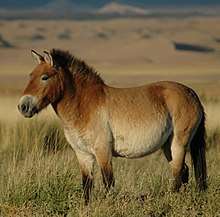 | |
| Przewalski's horse | |
| Scientific classification | |
| Kingdom: | Animalia |
| Phylum: | Chordata |
| Class: | Mammalia |
| Order: | Perissodactyla |
| Family: | Equidae |
| Genus: | Equus |
| Species: | |
| Subspecies: | E. f. przewalskii |
| Trinomial name | |
| Equus ferus przewalskii (L. S. Poliakov, 1881) | |
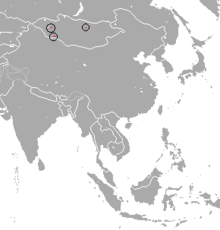 | |
| Przewalski's horse range (reintroduced) | |
| Synonyms | |
|
hagenbecki Matschie, 1903 | |
.jpg)
Common names for this equine include takhi,[6] Asian wild horse, and Mongolian wild horse.[7] It is named after the Russian geographer and explorer Nikołaj Przewalski.
Most wild horses today, such as the American mustang or the Australian brumby, are actually feral horses descended from domesticated animals that escaped and adapted to life in the wild. Przewalski's horse has long been considered the only 'true' wild horse extant in the world today, never having been domesticated. However, a 2018 DNA study suggested that modern Przewalski's horses may descend from the domesticated horses of the Botai culture.[8][9]
Taxonomy
Przewalski's horse was described in 1881 by L. S. Poliakov, although the taxonomic position of Przewalski's horse remains controversial and no consensus exists whether it is a full species (Equus przewalskii), a subspecies of the wild horse (Equus ferus przewalskii, along with the other subspecies, domesticated horse E. f. caballus, and the extinct tarpan E. f. ferus)), or even a subpopulation of the domestic horse.[10][11][12]
Lineage
Early sequencing studies of DNA revealed several genetic characteristics of Przewalski's horse that differ from what is seen in modern domestic horses, indicating neither is ancestor of the other, and supporting the status of Przewalski horses as a remnant wild population not derived from domestic horses.[13] The evolutionary divergence of the two populations was estimated to have occurred about 45,000 YBP,[14][15] while the archaeological record places the first horse domestication about 5,500 YBP by the ancient central-Asian Botai culture.[14][16] The two lineages thus split well before domestication, probably due to climate, topography, or other environmental changes.[14]
Several subsequent DNA studies produced partially contradictory results. A 2009 molecular analysis using ancient DNA recovered from archaeological sites placed Przewalski's horse in the middle of the domesticated horses,[12] but a 2011 mitochondrial DNA analysis suggested that Przewalski's and modern domestic horses diverged some 160,000 years ago.[17] An analysis based on whole genome sequencing and calibration with DNA from old horse bones gave a divergence date of 38–72 thousand years ago.[18]
A new analysis in 2018 involved genomic sequencing of ancient DNA from mid-fourth-millennium B.C.E. Botai domestic horses, as well as domestic horses from more recent archaeological sites, and comparison of these genomes with those of modern domestic and Przewalski's horses. The study revealed that Przewalski's horses not only belong to the same genetic lineage as those from the Botai culture, but may be the feral descendants of these ancient domestic animals, rather than representing a surviving population of never-domesticated horses.[8] The Botai horses were found to have made only negligible genetic contribution to any of the other ancient or modern domestic horses studied, which must then have arisen from an independent domestication involving a different wild horse population.[8]
The karyotype of Przewalski's horse differs from that of the domestic horse by an extra chromosome pair because of the fission of domestic horse chromosome 5 to produce the Przewalski's horse chromosomes 23 and 24. In comparison, the chromosomal differences between domestic horses and zebras include numerous translocations, fusions, inversions and centromere repositioning.[19] This gives Przewalski's horse the highest diploid chromosome number among all equine species. They can interbreed with the domestic horse and produce fertile offspring (65 chromosomes).[10]
Population
The wild population was already rare at the time of the first scientific characterization of Przewalski's horse, and attempts to obtain specimens for exhibit and captive breeding were largely unsuccessful until 1902, when 28 captured foals were brought to Europe. These and a small number of additional captives would be distributed among zoos and breeding centers in Europe and the United States. Many facilities failed in their attempts at captive breeding, but a few programs were established. However, by the mid-1930s, inbreeding had caused reduced fertility and the captive population experienced a genetic bottleneck, with the surviving captive breeding stock descended from only 11 of the founder captives.[20]
In addition, in at least one instance the progeny of interbreeding with a domestic horse was bred back into the captive Przewalski's horse population, though recent studies have shown only minimal genetic contribution of this domestic horse to the captive population.[21] The situation was improved when the exchange of breeding animals among facilities increased genetic diversity and there was a consequent improvement in fertility, but the population experienced another genetic bottleneck when many of the horses failed to survive World War II. Only 9 of the 31 remaining horses at war's end became ancestors of the subsequent captive population, which did not return to its pre-war size until a decade later.[20] By 1965 there were more than 130 animals spread among thirty two zoos and parks, while genetic diversity received a much-needed boost from a new source: In 1957, a wild-caught mare captured as a foal a decade earlier was introduced into the Ukrainian captive population, and the spread of her bloodline through the inbred captive groups led to their increased reproductive success. This would prove the last wild-caught horse, and with the presumed extinction of wild population, last sighted in Mongolia in the late 1960s, the captive population became the sole representatives of Przewalski's horse.[20]
By 1979, when a concerted program of population management to maximize genetic diversity was begun, there were almost four hundred horses in sixteen facilities,[20] a number that had grown by the early 1990s to over 1,500.[22] Several populations have now been released into the wild. A cooperative venture between the Zoological Society of London and Mongolian scientists has resulted in successful reintroduction of these horses from zoos into their natural habitat in Mongolia; and as of 2011, an estimated total of almost 400 horses existed in three free-ranging populations in the wild.[23] In 2001, Przewalski's horses were reintroduced into the Kalamaili Nature Reserve in Xinjiang, China.[24] There are also free-range populations living in large enclosures at several sites,[23] and from 1998 a population has lived in the unenclosed Chernobyl Exclusion Zone, where with the absence of humans it is thought to be increasing in size.[25]
Characteristics
Przewalski's horse is stockily built in comparison to domesticated horses, with shorter legs. Typical height is about 12–14 hands (48–56 inches, 122–142 cm), length is about 2.1 m (6 ft 11 in). They weigh around 300 kilograms (660 lb). The coat is generally dun in color with pangaré features, varying from dark brown around the mane (which stands erect) to pale brown on the flanks and yellowish-white on the belly and around the muzzle. The legs of Przewalski's horse are often faintly striped, also typical of primitive markings.[26] The tail is about 90 cm (35.43 in) long, with a longer dock and shorter hair than seen in domesticated horses.
The hooves of Przewalski's horse are longer in the front and have significantly thicker sole horns than feral horses.[27] This is beneficial, as it improves the performance of the hooves.
The Przewalski's horse has 66 chromosomes, compared to 64 in all other horse species.[28]
Ecology and behavior
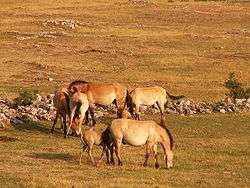
In the wild, Przewalski's horses live in small, permanent family groups consisting of one adult stallion, one to three mares, and their common offspring. Offspring stay in the family group until they are no longer dependent, usually at two or three years old. Bachelor stallions, and sometimes old stallions, join bachelor groups. Family groups can join together to form a herd that moves together.
The patterns of their daily lives exhibit horse behavior similar to that of feral horse herds. Stallions herd, drive, and defend all members of their family, while the mares often display leadership in the family. Stallions and mares stay with their preferred partners for years. While behavioral synchronization is high among mares, stallions other than the main harem stallion are generally less stable in this respect.
Home range in the wild is little studied, but estimated as 1.2-24 km2 in the Hustai National Park and 150-825 km2 in the Great Gobi B Strictly Protected Area.[29]
Horses maintain visual contact with their family and herd at all times, and have a host of ways to communicate with one another, including vocalizations, scent marking, and a wide range of visual and tactile signals. Each kick, groom, tilt of the ear, or other contact with another horse is a means of communicating. This constant communication leads to complex social behaviors among Przewalski's horses.[30]
Diet
Przewalski horse's diet consists mostly of vegetation. Many plant species are in a typical Przewalski's horse environment, including: Elymus repens, Carex spp., Fabaceae, and Asteraceae.[31] While the horses eat a variety of different plant species, they tend to favor one species during a specific time of the year. In other words, Przewalski's horses have seasonal food preferences. In the springtime, they favor Elymus repens, Corynephorus canescens, Festuca valesiaca, and Chenopodium album. In early summer, they favor Dactylis glomerata and Trifolium, and in late summer, they gravitate towards E. repens and Vicia cracca.[31] In winter, for example, the horses eat Salix spp., Pyrus communis, Malus sylvatica, Pinus sylvestris, Rosa spp., and Alnus spp. Additionally, Przewalski's horses may dig for Festuca spp., Bromus inermis, and E. repens that grow beneath the ice and snow. Their winter diet is very similar to the diet of domestic horses.[31] In the wintertime, Przewalski's horses experience hypodermis, a condition in which one's metabolic rate slows down. They eat their food more slowly than they do during other times of the year. Looking at the species diet overall, however, Przewalski's horses most often eat E. repens, Trifolium pratense, Vicia cracca, Poa trivialis, Dactylis glomerata, and Bromus inermis.[31]
Reproduction
Mating occurs in late spring or early summer. Mating stallions do not start looking for mating partners until the age of five. Stallions assemble groups of mares or challenge the leader of another group for dominance. Females are able to give birth at the age of three and have a gestation period of 11-12 months. Foals are able to stand about an hour after birth.[32] The rate of infant mortality among foals is 25%, with 83.3% of these deaths resulting from leading stallion infanticide.[24] Foals begin grazing within a few weeks but are not weaned for 8-13 months after birth.[32] They reach sexual maturity at two years of age.[33]
History
In the 15th century, Johann Schiltberger recorded one of the first European sightings of the horses in the journal of his trip to Mongolia as a prisoner of the Mongol Khan.[34] The horse is named after a Russian colonel of Polish descent, Nikolai Przhevalsky (1839–1888) (Nikołaj Przewalski in Polish). He was the explorer and naturalist who first described the horse in 1881, after having gone on an expedition to find it, based on rumors of its existence. Many of these horses were captured around 1900 by Carl Hagenbeck and placed in zoos. As noted above, about 12-15 reproduced and formed today's population.
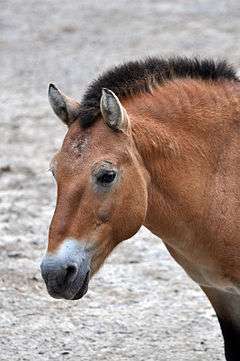
The native population declined in the 20th century due to a combination of factors, with the wild population in Mongolia dying out in the 1960s. The last herd was sighted in 1967, and the last individual horse in 1969. Expeditions after this failed to locate any horses, and the species had been designated "extinct in the wild" for over 30 years.
After 1945, only two captive populations in zoos remained, in Munich and in Prague. The most valuable group, in Askania Nova, Ukraine, was shot by German soldiers during World War II occupation, and the group in the United States had died out. Competition with livestock, hunting, capture of foals for zoological collections, military activities, and harsh winters recorded in 1945, 1948, and 1956 are considered to be the main causes of the decline in Przewalski's horse population. By the end of the 1950s, only 12 individual horses were left in the world.[35]
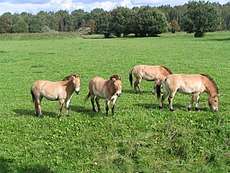
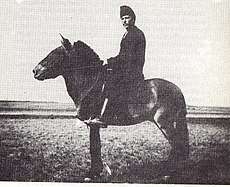
In 1977, the Foundation for the Preservation and Protection of the Przewalski Horse was founded in Rotterdam, the Netherlands, by Jan and Inge Bouman. The foundation started a program of exchange between captive populations in zoos throughout the world to reduce inbreeding, and later began a breeding program of its own. As a result of such efforts, the extant herd has retained a far greater genetic diversity than its genetic bottleneck made likely.[35]
Since 1986, Chinese researchers have bred Przewalski's horses in captivity, with the program seeing over 20 years of success.
In 1992, 16 horses were released into the wild in Mongolia, followed by additional animals later on. One of the areas to which they were reintroduced became Khustain Nuruu National Park in 1998. Another reintroduction site is Great Gobi B Strictly Protected Area, located at the fringes of the Gobi desert. Lastly, in 2004 and 2005, 22 horses were released by the Association Takh to a third reintroduction site in the buffer zone of the Khar Us Nuur National Park, in the northern edge of the Gobi ecoregion. In the winter of 2009–2010, one of the worst dzud or snowy winter conditions ever hit Mongolia. The population of Prezewalski's horse in the Great Gobi B SPA was drastically affected, providing clear evidence of the risks associated with reintroducing small and sequestered species in unpredictable and unfamiliar environments.
Since 2011, Prague Zoo has transported 35 horses to Mongolia in eight rounds, in cooperation with partners (Czech Air Force, European Breeding Programme for Przewalski's Horses, Association pour de cheval du Przewalski: Takh, Czech Development Agency, Czech Embassy in Mongolia and others) and it plans to continue to return horses to the wild in the future. In the framework of the project Return of the Wild Horses, it sustains its activities by supporting local inhabitants. The zoo has the longest uninterrupted history of breeding Przewalski's horses in the world and keeps the studbook of this species.
The reintroduced horses successfully reproduced, and the status of the animal was changed from "extinct in the wild" to "endangered" in 2005.[22] On the IUCN Red List, they were reclassified from "extinct in the wild" to "critically endangered" after a reassessment in 2008[36] and from "critically endangered" to "endangered" after a 2011 reassessment.[23]
Conservation efforts
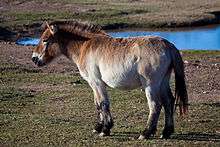
While dozens of zoos worldwide have Przewalski's horses in small numbers, specialized reserves are also dedicated primarily to the species. The world's largest captive-breeding program for Przewalski's horses is at the Askania Nova preserve in Ukraine. Thirty one horses were also released in the area evacuated after the Chernobyl accident, which now serves as a deserted de facto nature reserve.[37] In Chernobyl, the population reached 65 individuals in 2003, but poachers decreased their number to an estimated 30–40 individuals by 2011.[38] An intensely researched population of free-ranging animals was also introduced to the Hortobágy National Park puszta in Hungary; data on social structure, behavior, and diseases gathered from these animals are used to improve the Mongolian conservation effort.
Several American zoos also collaborated in breeding E. f. przewalskii from 1979 to 1982.[39] Recent advances in equine reproductive science in the United States also have potential to further preserve and expand the gene pool. In October 2007, scientists at the Smithsonian Institution's National Zoo successfully reversed a vasectomy on a Przewalski's horse — the first operation of its kind on this species and possibly the first ever on any endangered species. While normally a vasectomy may be performed on an endangered animal under limited circumstances, particularly if an individual has already produced many offspring and its genes are overrepresented in the population, scientists realized the animal in question was one of the most genetically valuable Przewalski's horses in the North American breeding program.[40] The first birth by artificial insemination occurred on 27 July 2013, at the Smithsonian Conservation Biology Institute.[41][42]
Le Villaret, located in the Cevennes National Park in southern France and run by the Association Takh, is a breeding site for Przewalski's horses that was created to allow the free expression of natural Przewalski's horse behaviors. Eleven zoo-born horses were brought to Le Villaret in 1993. Horses born there are adapted to life in the wild; they are free to choose their own mates and must forage on their own. Such a unique breeding site was necessary to produce the individuals that were reintroduced to Mongolia in 2004 and 2005. In 2012, 39 individuals were at Le Villaret.[43]
The Przewalski's Horse Reintroduction Project of China was initiated in 1985 when 11 wild horses were imported from overseas. After more than two decades of effort, the Xinjiang Wild Horse Breeding Centre has bred a large number of the horses, 55 of which were released into the Kalamely Mountain area. The animals quickly adapted to their new environment. In 1988, six foals were born and survived, and by 2001, over 100 horses were at the centre. As of 2013, the center hosted 127 horses divided into 13 breeding herds and three bachelor herds.
Reintroductions organized by Western European countries started in the 1990s. These were later stopped, mostly for financial reasons. In 2011, Prague Zoo started a new project, Return of the Wild Horses. With the support of public and many strategic partners, these yearly transports of captive-bred horses into the Great Gobi B Strictly Protected Area continue today.[44] Since 2004, there is also a program to reintroduce Przewalski's horses that were bred in France into Mongolia.[45]
In popular culture
The historical fiction novel The Winter Horses by Philip Kerr tells the story of two people at Askaniya-Nova biosphere reserve in Ukraine who attempt to save Przewalski's horses from the dinner tables of Nazi soldiers during World War II.[46]
In The Wild Thornberrys, Eliza Thornberry unsuccessfully tries to tame and ride a Przewalski's horse in the Season 3 episode "Horse Sense".
See also
- Mongolian horse (domestic)
References
- Boyd, L. & King, S. R. B. (2011). "Equus ferus ssp. przewalskii". IUCN Red List of Threatened Species. 2011. Retrieved 24 June 2012.CS1 maint: ref=harv (link)
- "Przewalski's horse". Merriam-Webster Dictionary.
- "Przewalski". Oxford English Dictionary (3rd ed.). Oxford University Press. September 2005. (Subscription or UK public library membership required.)
- "The Takhi". International Takhi-Group. Archived from the original on 19 July 2012. Retrieved 25 October 2010.
- Grubb, P. (2005). "Order Perissodactyla". In Wilson, D.E.; Reeder, D.M (eds.). Mammal Species of the World: A Taxonomic and Geographic Reference (3rd ed.). Johns Hopkins University Press. p. 630–631. ISBN 978-0-8018-8221-0. OCLC 62265494.
- "Takhi: Holy Animal of Mongolia". International Takhi Group. Retrieved 13 August 2016.
- "Equus ferus ssp. przewalskii". IUCN Red List of Threatened Species. Retrieved 13 August 2016.
- Pennisi, Elizabeth (22 February 2018). "Ancient DNA upends the horse family tree". sciencemag.org.
- Orlando, Ludovic; Outram, Alan K.; Librado, Pablo; Willerslev, Eske; Zaibert, Viktor; Merz, Ilja; Merz, Victor; Wallner, Barbara; Ludwig, Arne (6 April 2018). "Ancient genomes revisit the ancestry of domestic and Przewalski's horses". Science. 360 (6384): 111–114. doi:10.1126/science.aao3297. ISSN 0036-8075. PMID 29472442.
- Lau, Allison; Lei Peng; Hiroki Goto; Leona Chemnick; Oliver A. Ryder; Kateryna D. Makova (2009). "Horse Domestication and Conservation Genetics of Przewalski's Horse Inferred from Sex Chromosomal and Autosomal Sequences". Mol. Biol. Evol. 26 (1): 199–208. doi:10.1093/molbev/msn239. PMID 18931383.
- Kavar, Tatjana; Peter Dovč (2008). "Domestication of the horse: Genetic relationships between domestic and wild horses". Livestock Science. 116 (1–3): 1–14. doi:10.1016/j.livsci.2008.03.002.
- Cai, Dawei; Zhuowei Tang; Lu Han; Camilla F. Speller; Dongya Y. Yang; Xiaolin Ma; Jian'en Cao; Hong Zhu; Hui Zhou (2009). "Ancient DNA provides new insights into the origin of the Chinese domestic horse". Journal of Archaeological Science. 36 (3): 835–842. doi:10.1016/j.jas.2008.11.006.
- Goto, Hiroki; Ryder, Oliver A.; Fisher, Allison R.; Schultz, Bryant; Pond, Sergei L. Kosakovsky; Nekrutenko, Anton; Makova, Kateryna D. (1 January 2011). "A massively parallel sequencing approach uncovers ancient origins and high genetic variability of endangered Przewalski's horses". Genome Biology and Evolution. 3: 1096–1106. doi:10.1093/gbe/evr067. ISSN 1759-6653. PMC 3194890. PMID 21803766. Archived from the original on 27 July 2015. Retrieved 3 February 2016.
- Machugh, David E.; Larson, Greger; Orlando, Ludovic (2016). "Taming the past: Ancient DNA and the study of animal domestication". Annual Review of Animal Biosciences. 5: 329–351. doi:10.1146/annurev-animal-022516-022747. PMID 27813680.
- der Sarkissian, C.; Ermini, L.; Schubert, M.; Yang, M.A.; Librado, P.; et al. (2015). "Evolutionary genomics and conservation of the endangered Przewalski's horse". Curr. Biol. 25 (19): 2577–83. doi:10.1016/j.cub.2015.08.032. PMC 5104162. PMID 26412128.
- Outram, A.K.; Stear, N.A.; Bendrey, R.; Olsen, S.; Kasparov, A.; et al. (2009). "The earliest horse harnessing and milking". Science. 323 (5919): 1332–1335. doi:10.1126/science.1168594. PMID 19265018.
- O A Ryder, A R Fisher, B Schultz, S Kosakovsky Pond, A Nekrutenko, K D Makova. "A massively parallel sequencing approach uncovers ancient origins and high genetic variability of endangered Przewalski's horses". Genome Biology and Evolution. 2011
- Orlando, L.; Ginolhac, A.L.; Zhang, G.; Froese, D.; Albrechtsen, A.; Stiller, M.; et al. (2013). "Recalibrating Equus evolution using the genome sequence of an early Middle Pleistocene horse". Nature. 499 (7456): 74–78. doi:10.1038/nature12323. PMID 23803765.
- Piras, F.M.; Nergadze, S.G.; Poletto, V.; Cerutti, F.; Ryder, O.A.; Leeb, T.; Raimondi, E.; Giulotto, E. (2009). "Phylogeny of Horse Chromosome 5q in the Genus Equus and Centromere Repositioning". Cytogenetic and Genome Research. 126 (1–2): 165–172. doi:10.1159/000245916. PMID 20016166.
- Bouman, Inge; Bouman, Jan (1994). Boyd, Lee; Houpt, Katherine A. (eds.). The History of Przewalski's Horse. Przewalski's Horse. pp. 5–38. ISBN 9780791418895.
- Bowling, Ann T.; Ryder, Oliver A. (1987). "Genetic studies of blood markers in Przewalski's horse" (PDF). The Journal of Heredity. 78 (2): 75–80. doi:10.1093/oxfordjournals.jhered.a110340. PMID 3584938.
- "An extraordinary return from the brink of extinction for worlds last wild horse". ZSL Living Conservation. 19 December 2005. Archived from the original on 12 February 2012.
- "Another leap towards the Barometer of Life". International Union for the Conservation of Nature. November 10, 2011. Archived from the original on November 15, 2011.
- Chen, Jinliang; Weng, Qiang; Chao, Jie; Hu, Defu; Taya, Kazuyoshi (2008). "Reproduction and Development of the Released Przewalski's Horses (Equus przewalskii) in Xinjiang, China". Journal of Equine Science. 19 (1): 1–7. doi:10.1294/jes.19.1. PMC 4019202. PMID 24833949.
- Wendle, John. "Animals Rule Chernobyl 30 Years After Nuclear Disaster". National Geographic. Retrieved 2 May 2016.
- "Przewalski's horse". Smithsonian's National Zoo. Retrieved 26 April 2019.
- Patan-Zugaj, B., Hermann, C., & Budras, K.-D. (2013). History of the Przewalski horse (Equus Przewalskii) and morphological examination of seasonal changes of the hoof in Prze-walski and feral horses. Retrieved from http://www.pferdeheilkunde.de/10.21836/PEM20130302.
- Gaddy, L. L. (2005). Biodiversity: Przewalski's Horse, Edna's Trillium, the Giant Squid, and Over 1.5 Million Other Species. p. 6. ISBN 9780761830894.
- "Przewalski's Horse (Equus ferus) Fact Sheet: Behavior & Ecology". San Diego Zoo Global Library – via IELC.
- Feh, C. (2005). "Relationships and communication in socially natural horse herds". In Mills, Daniel; McDonnell, Sue (eds.). The Domestic Horse: the evolution, development and management of its behaviour. Cambridge University Press.
- Kateryna Slivinska; Grzegorz Kopij (July 2011). "Diet of the Przewalski's horse Equus przewalskii in the Chernobyl exclusion zone" (PDF). Polish Journal of Ecology. 59 (4): 841–847. Archived from the original (PDF) on 29 October 2013.
- Luu, J. "Equus caballus przewalskii". Animal Diversity Web. University of Michigan Museum of Zoology.
- "Przewalski's Horse". aboutanimals.
- "Przewalski Horse". Breeds of Livestock, Department of Animal Science. Breeds of Livestock. Oklahoma State University. Archived from the original on 17 October 2014. Retrieved 29 April 2019.
- O. A. Ryder et al, ibid
- "Equus ferus (Asian Wild Horse, Mongolian Wild Horse, Przewalski's Horse)". IUCN Red List of Threatened Species.
- Mulvey, Stephen (20 April 2006). "Wildlife defies Chernobyl radiation". BBC News. Retrieved 3 October 2007.
- Gill, Victoria (27 July 2011). "Chernobyl's Przewalski's horses are poached for meat". BBC Nature. Archived from the original on 27 April 2018. Retrieved 2 May 2016.
- Rydera, Oliver A.; Wedemeyera, Elizabeth A. (April 1982). "Cooperative breeding programme for the Mongolian wild horse Equus przewalskii in the United States". Biological Conservation. 22 (4): 259–271. doi:10.1016/0006-3207(82)90021-0.
- Zongker, Brett (June 17, 2008). "Rare horse gets reverse vasectomy". Today.com / NBC News. Associated Press. Archived from the original on May 12, 2013. Retrieved April 6, 2013.
- "Przewalski's Horse Foal Born via Artificial Insemination". TheHorse.com. 2 August 2013.
- Shenk, Emily (5 August 2013). "First Przewalski's Horse Born Via Artificial Insemination". National Geographic. Retrieved 14 August 2013.
- Przewalski's Horse - the last wild horse, Association Takh
- "Return of the Przewalski's Horse to Mongolia". Zoo Praha. Retrieved 27 June 2019.
- Strauss, Gary (17 November 2016). "A Wild Horse on the Comeback Trail". National Geographic. Retrieved 14 April 2019.
- Kerr, Philip (2014). The winter horses. London: Walker Books. OCLC 904260670.
Further reading
- Boyd, Lee; Houpt, Katherine A. (1994). Przewalski's Horse: The history and biology of an endangered species. Albany, New York: State University of New York Press. ISBN 978-0-7914-1889-5. OCLC 28256312 – via Google Books.
- "FC Wales turns clock back thousands of years with 'wild' solution to looking after ancient forest site" (Media release). Forestry Commission, Wales, U.K. 16 September 2004. No: 7001. Archived from the original on 6 July 2006.
- "Usage of 17 specific names based on wild species which are pre-dated by or contemporary with those based on domestic animals (Lepidoptera, Osteichthyes, Mammalia): conserved". Bull. Zool. Nomencl. International Commission on Zoological Nomenclature. 60: 81–84. 2003. Opinion 2027 (Case 3010). Archived from the original on 24 February 2006.
- Ishida, Nobushige; et al. (1995). "Mitochondrial DNA sequences of various species of the genus Equus with special reference to the phylogenetic relationship between Przewalskii's wild horse and domestic horse". Journal of Molecular Evolution. 41 (2): 180–188. doi:10.1007/BF00170671. PMID 7666447.
- Jansen, Thomas; et al. (2002). "Mitochondrial DNA and the origins of the domestic horse". PNAS. 99 (16): 10905–10910. doi:10.1073/pnas.152330099. PMC 125071. PMID 12130666.
- King, S. R. B.; Gurnell, J. (2006). "Scent-marking behaviour by stallions: an assessment of function in a reintroduced population of Przewalski horses (Equus ferus przewalskii)". Journal of Zoology. 272 (1): 30–36. doi:10.1111/j.1469-7998.2006.00243.x.
- van Cleaf, K. (2006). Przewalski's Horses (Print ed.). Edina, MN: ABDO Pub. Co.CS1 maint: multiple names: authors list (link)
- Wakefield, S.; Knowles, J.; Zimmermann, W.; Van Dierendonck, M. (2002). "Status and action plan for the Przewalski's Horse (Equus ferus przewalski)" (PDF). In Moehlman, P.D. (ed.). Equids: Zebras, Asses and Horses. Status Survey and Conservation Action Plan. IUCN/SSC Equid Specialist Group. Gland, Switzerland and Cambridge, UK: IUCN. pp. 82–92.
- Wilford, John Noble (11 October 2005). "Foal by Foal, the Wildest of Horses Is Coming Back". New York Times.
- "Financial losses puts at risk Chinese program of reintroducing Przewalski's horses". Welcome2Mongolia. Archived from the original on 29 May 2009.
- [no title given]. PBS (video).
- Chen, Xia; Huang, Shan (28 December 2007). "Returning Home — Przewalski's horse reintroduction project". China.org.cn.
- "Przewalski's horse - Equus ferus przewalskii". IUCN SSC Equid Specialist Group.
- Slivinska, Kateryna; Kopij, Grzegorz (2011). "Diet of the Przewalski's Horse Equus Przewalskii in the Chernobyl Exclusion Zone". Polish Journal of Ecology. 59: 841–47.
- Scheibe, KM; Eichhorn, K.; Kalz, B.; Streich, WJ; Scheibe, A. (1998). "Water consumption and watering behavior of Przewalski horses (Equus ferus przewalskii) in a semi-reserve". Zoo Biology. 17 (3): 181–192. doi:10.1002/(sici)1098-2361(1998)17:3<181::aid-zoo3>3.3.co;2-m.
- Brinkmann, Lea; Gerken, Martina; Riek, Alexander (2012). "Adaptation Strategies to Seasonal Changes in Environmental Conditions of a Domesticated Horse Breed, the Shetland Pony (Equus ferus caballus)". Journal of Experimental Biology. 215 (7): 1061–1068. doi:10.1242/jeb.064832. PMID 22399650.
- Ferreira, Luis Miguel M.; Celaya, Rafael; Benavides, Raquel; Jauregui, Berta M.; Garcia, Urcesino; Sofia Santos, Ana; Rosa Garcia, Rocio; Miguel; Rodrigues, Antonio M.; Osoro, Koldo (2013). "Foraging Behaviour of Domestic Herbivore Species Grazing on Heathlands Associated with Improved Pasture Areas". Livestock Science. 155 (2–3): 373–383. doi:10.1016/j.livsci.2013.05.007.
- McCue, Molly E.; Bannasch, Danika L.; Petersen, Jessica L.; Gurr, Jessica; Bailey, Ernie; Binns, Matthew M.; Distl, Ottmar; Guerin, Gerard; Hasegawa, Telhisa; Hill, Emmeline W.; Leeb, Tosso; Lindgren, Gabriella; Penedo, M. Cecilia T.; Roed, Knut H.; Ryder, Oliver A.; Swinburne, June E.; Tozaki, Teruaki; Valberg, Stephanie J.; Vaudin, Mark; Lindblad-Toh, Kerstin; Wade, Claire M.; Mickelson, James R. (2012). "A High Density SNP Array for the Domestic Horse and Extant Perissodactyla: Utility for Association Mapping, Genetic Diversity, and Phylogeny Studies". PLOS Genetics. 8 (1): e1002451. doi:10.1371/journal.pgen.1002451. PMC 3257288. PMID 22253606.CS1 maint: uses authors parameter (link)
- Goto, Hiroki; Ryder, Oliver A.; Fisher, Allison R.; Schultz, Bryant; Pond, Sergei L. Kosakovsky; Nekrutenko, Anton; Makova, Kateryna D. (1 January 2011). "A massively parallel sequencing approach uncovers ancient origins and high genetic variability of endangered Przewalski's horses". Genome Biology and Evolution. 3: 1096–1106. doi:10.1093/gbe/evr067. ISSN 1759-6653. PMC 3194890. PMID 21803766. Archived from the original on 27 July 2015. Retrieved 3 February 2016.
- Heptner, V.G.; Nasimovich, A.A.; Bannikov, A.G.; Hoffman, R.S. (1988). Mammals of the Soviet Union. I. Washington, DC: Smithsonian Institution Libraries and National Science Foundation.CS1 maint: uses authors parameter (link)
- Ridgeway, William (1908). "Environment and race". The Geographical Journal. Royal Geographical Society. 32 (4): 405–412, esp. 407. doi:10.2307/1776930. JSTOR 1776930.
External links
| Wikimedia Commons has media related to Equus przewalskii. |
| Wikispecies has information related to Equus ferus przewalskii |
- Przewalski’s horse at the Encyclopædia Britannica
- "images and movies of the Przewalski's horse (Equus ferus przewalskii)". ARKive. Archived from the original on 7 May 2006.
- "Details of the re-introduction program for Przewalski's horse".
- "Umbrella organization of all institutions participating in the reintroduction of takhis in Mongolia". Archived from the original on 28 September 2006.
- "General studbook of Przewalski's horse".
- "Przewalski horse conservation organization, reintroduced the species to Mongolia in 2004 and 2005 and continues research and conservation on the Mongolian steppe". Association Takh.
